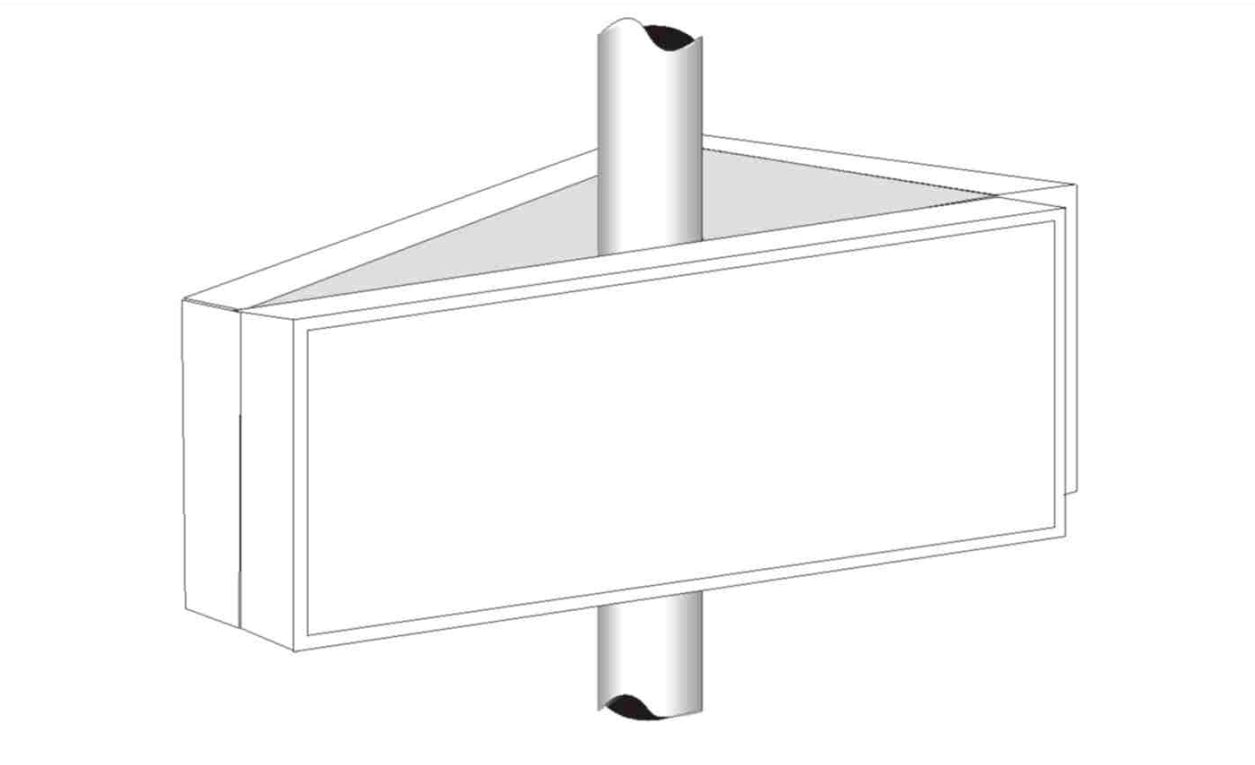
The Sign Lighting Energy Requirements apply to all internally illuminated signs, externally illuminated signs, unfiltered light emitting diodes (LEDs), and unfiltered neon, whether used indoors or outdoors. Examples include cabinet signs, channel letters, lightboxes, backlit signs, illuminated billboards, and electronic message centers.
The following sign lighting applications are not required to comply with the sign lighting energy requirements:
1. Unfiltered incandescent lamps that are not part of an electronic message center (EMC), an internally illuminated sign, or an externally illuminated sign.
This exception applies only to portions of a sign that are unfiltered incandescent lamps. An unfiltered sign is defined in the Energy Standards as a sign where the viewer perceives the light source directly as the message, without any colored filter between the viewer and the light source. Although internally illuminated signs are mentioned in this exception, it is only those portions of a hybrid sign consisting of unfiltered incandescent lamps that are excluded from the sign lighting energy requirements
2. Exit signs.
However, exit signs are required to meet the requirements of the Appliance Efficiency Regulations.
3. Traffic Signs.
However, traffic signs are required to meet the requirements of the Appliance Efficiency Regulations.
There are two options available for complying with the sign lighting energy requirements:
Option 1 - Maximum Allowed Lighting Power (Watts per square foot Approach).
Option 2 - List of Compliant Alternate Lighting Sources.
This option for complying with the sign lighting energy requirements is also known as the watts per square foot approach. When using this option, there are rules in the Energy Standards for classifying the lighting technology used, and for determining sign lighting power. Additional information about Sign Lighting Installed Wattage is in Section 7.2.4 of this chapter.
The maximum allowed lighting power is different for internally illuminated signs and for externally illuminated signs, as follows:
A. For internally illuminated signs, the maximum allowed lighting power shall not exceed the product of the illuminated sign area and 12 watts per square foot of the illuminated sign area (see Figures 7-1 and 7-2 below). For double-faced signs, only the area of a single face shall be used to determine the allowed lighting power (see Figure 7-3 below).
Internally illuminated signs are defined in the Energy Standards as signs that are illuminated by a light source that is contained inside a sign where the message area is luminous, including cabinet signs and channel letter signs.
B. For externally illuminated signs, the maximum allowed lighting power shall not exceed the product of the illuminated sign area and 2.3 watts per square foot of the illuminated sign area. Only areas of an externally lighted sign that are illuminated without obstruction or interference, by one or more luminaires, shall be used.
Externally illuminated signs are defined in the Energy Standards as any sign or a billboard that is lit by a light source that is external to the sign directed towards and shining on the face of the sign.
C. Lighting for unfiltered light emitting diodes (LEDs) and unfiltered neon are not required to comply with the maximum allowed lighting power option, but are required to comply with the alternate lighting source compliance method.

Include area from each face when separated by an opaque divider
Figure
7-2:
Single-faced Internally Illuminated Cabinet Sign with Fluorescent Lamps and
Translucent Face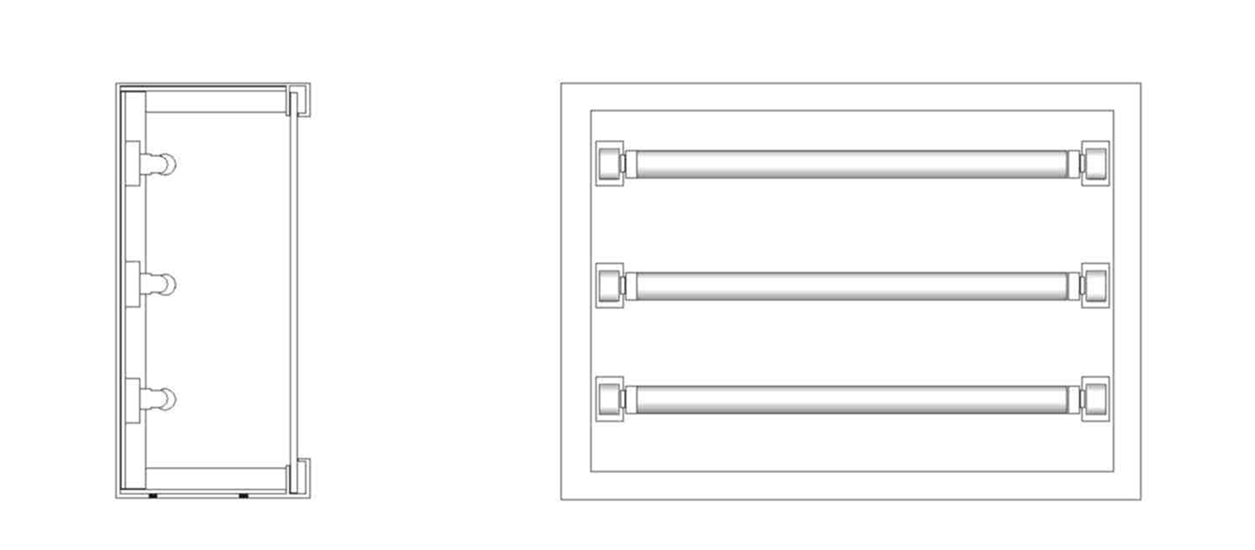
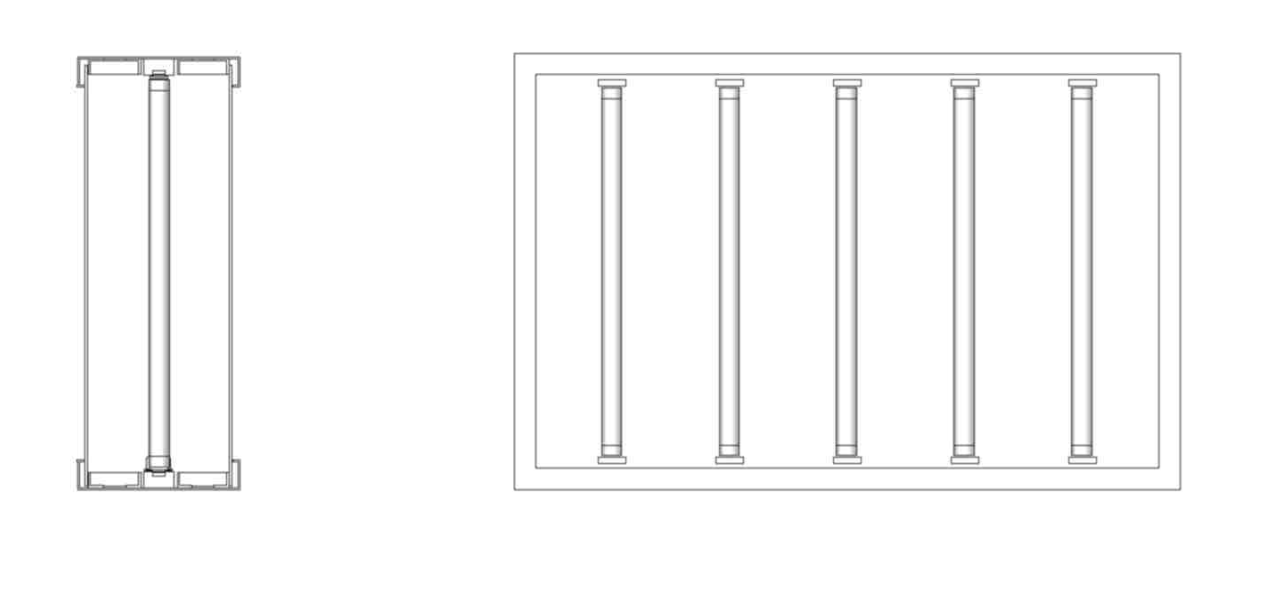
This option for complying with the sign lighting energy requirements is to use only lighting technologies on the list of compliant lighting sources. When using this option for compliance, there is no requirement to calculate lighting power.
A. List of Compliant Alternate Lighting Sources - A sign complies if it is equipped only with one or more of the following light sources:
1. High pressure sodium lamps.
2. Metal halide lamps that are:
•Pulse start or ceramic served by a ballast that has a minimum efficiency of 88 percent or greater, or
•Pulse start that are 320 watts or smaller, are not 250 watts or 175 watts, and are served by a ballast that has a minimum efficiency of 80 percent.
Ballast efficiency is the measured output wattage to the lamp divided by the measured operating input wattage when tested according to ANSI C82.6-2005.
3. Neon or cold cathode lamps with transformer or power supply efficiency greater than or equal to one of the following:
•A minimum efficiency of 75 percent when the transformer or power supply rated output current is less than 50 mA.
•A minimum efficiency of 68 percent when the transformer or power supply rated output current is 50 mA or greater.
The ratio of the output wattage to the input wattage is at 100 percent tubing load.
4. Fluorescent lighting systems meeting one of the following requirements:
•Use only lamps with a minimum color rendering index (CRI) of 80.
•Use only electronic ballasts with a fundamental output frequency not less than 20 kHz.
5. Light emitting diodes (LEDs) with a power supply having an efficiency of 80 percent or greater.
EXCEPTION to §140.8(b)5: Instead of requiring a power supply with an efficiency of 80 percent or greater, single voltage external power supplies that are designed to convert 120 volt AC input into lower voltage DC or AC output, and which have a nameplate output power less than or equal to 250 watts, shall be certified to comply with the applicable requirements for external power supplies in the Appliance Efficiency Regulations
6. Compact fluorescent lamps that do not contain a medium screw base sockets (E24/E26).
A sign may consist of multiple components, where some components are regulated, and some components are not regulated. For example, a single sign structure may have a regulated internally illuminated cabinet, plus regulated externally illuminated letters which are attached to a brick pedestal, plus unregulated unfiltered incandescent “chaser” lamps forming an illuminated arrow. For example, Figure 7-4 shows an arrow which is not part of an electronic message center (EMC) using incandescent lamps.
If the lamps are not covered by a lens, then only the control regulations (§130.3) apply to the sign. This type of unfiltered incandescent sign is not regulated by §140.8.
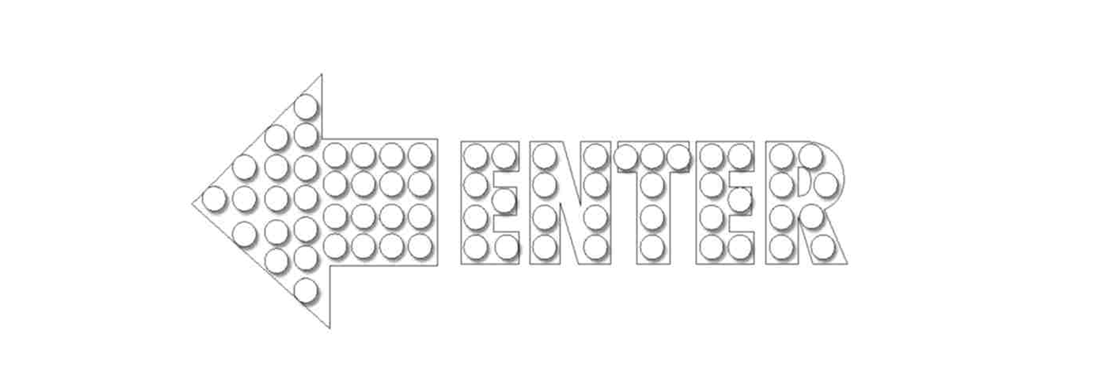
Figure 7-5 shows an externally illuminated sign using flood lighting, which is regulated by the Energy Standards. The power (wattage) used for these lighting components must comply with the watts per square foot approach, or use only lighting technologies approved according to §140.8(b).
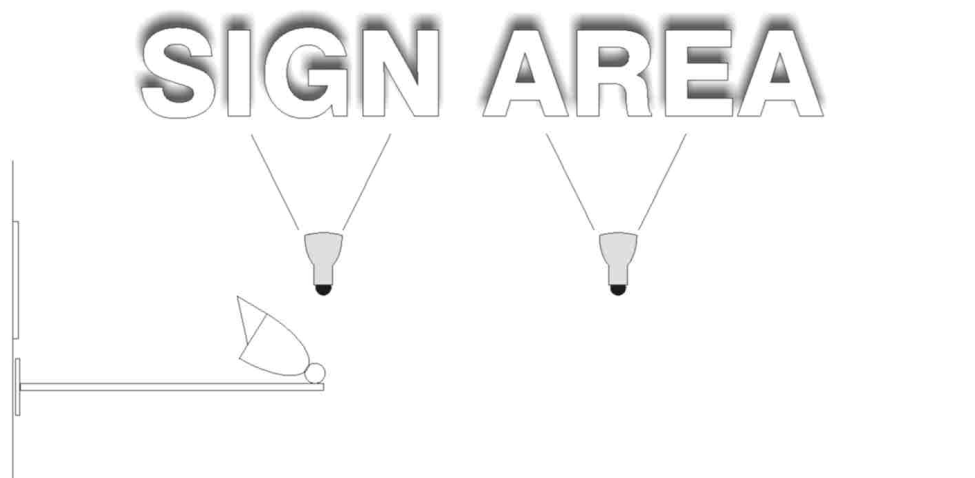
Example 7-2
Question
Can I use neon or cold cathode lights in my sign and comply with the Energy Standards under Option 2 (Compliant Alternate Lighting Sources)?
Answer
Yes, neon and cold cathode lights are allowed under the alternate light source compliance option, provided that the transformers or power supplies have an efficiency of 75 percent or greater for output currents less than 50 mA and 68 percent or greater for output currents 50 mA or greater.
Example 7-3
Question
Do signs inside a theater lobby or other indoor environments need to comply with the sign requirements?
Answer
Yes, all internally and externally illuminated signs whether indoor or outdoor must comply with either the Maximum Allowed Lighting Power or Compliant Alternate Lighting Sources compliance option.
Example 7-4
Question
My sign is equipped with both hardwired compact fluorescent lamps and incandescent lamps. Can my sign comply under the Compliant Alternate Lighting Sources option?
Answer
No. Since your sign is not exclusively equipped with energy efficient technologies allowed under the Compliant Alternate Lighting Sources option (incandescent sources are not allowed), it therefore must comply under the Maximum Allowed Lighting Power compliance option. Your other option is to replace the incandescent sources with an energy efficient option that is permitted under the specific technology approach, such as compliant LED, pulse start or ceramic metal halide, or fluorescent.
Example 7-5
Question
My sign has three parts: an internally illuminated panel sign equipped with electronic ballasts, and two unfiltered 30 mA neon signs on top and bottom of the panel sign displaying an illuminated arrow and lettering having power supplies with an efficiency of 76 percent. Does this sign comply with the Compliant Alternate Lighting Sources option?
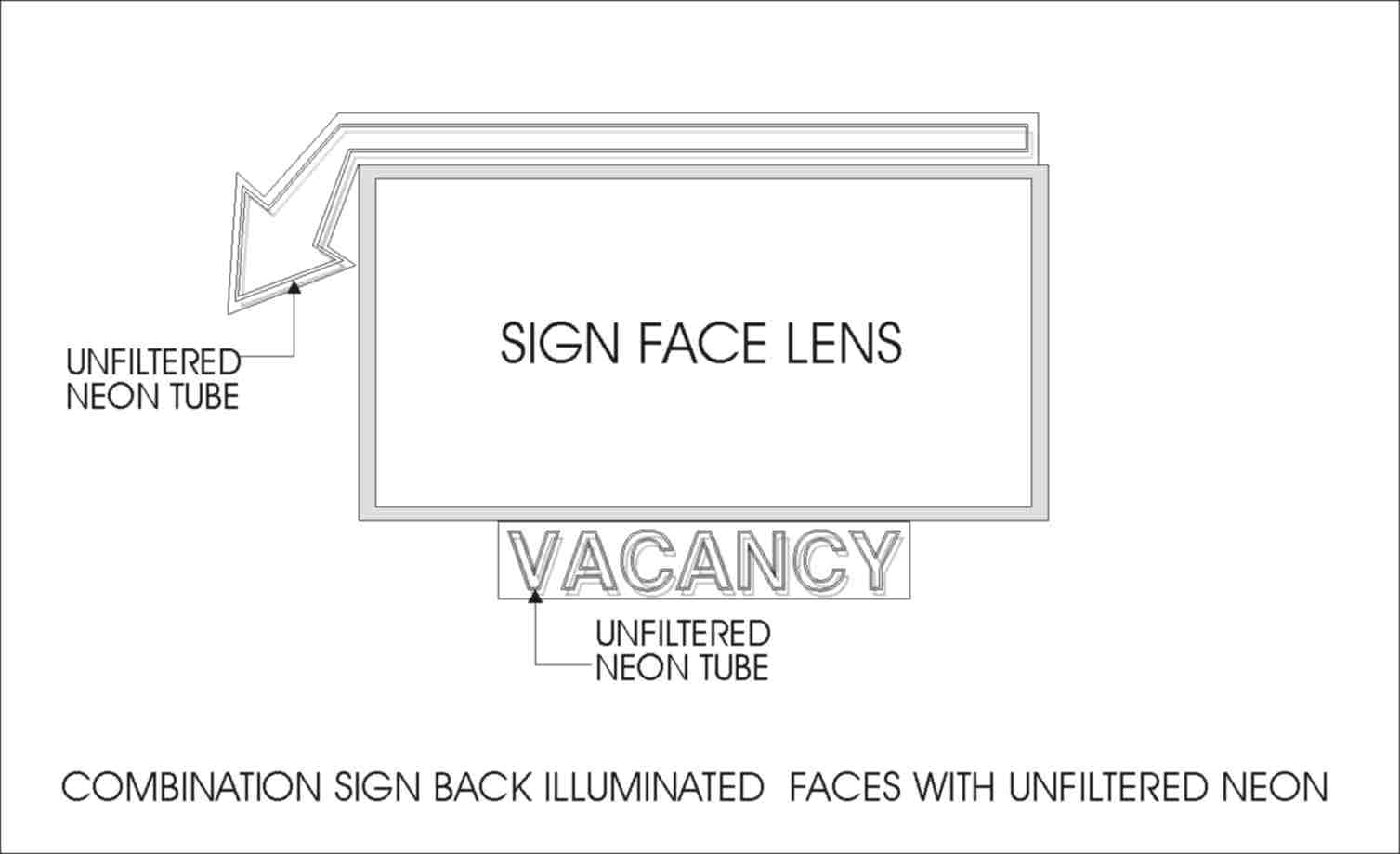
Answer
Yes, as long as the internally illuminated panel portion is illuminated with a compliant technology. This sign is essentially made up of three different signs; an internally illuminated panel sign and two unfiltered neon signs with efficient power supplies that comply with the Compliant Alternate Lighting Sources option. Therefore the entire sign complies with the Energy Standards as long as the separate parts comply.
Example 7-6
Question
Are signs required to comply with Outdoor Lighting Zone requirements?
Answer
No. Outdoor Lighting Zones do not apply in any way to signs. The Sign Lighting Standards are the same throughout the state; they do not vary with Outdoor Lighting Zones.